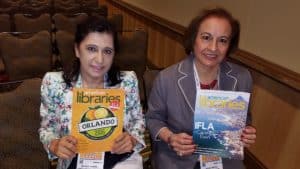
What’s one way to change up the way you teach information literacy? Gamification. And members of ALA’s Library Information Technology Association (LITA) gathered on a panel Monday morning to share examples of how they applied gamification in their own libraries.
The panel included:
- moderator Breanne Kirsch, public services librarian at the University of South Carolina Upstate in Spartanburg;
- Joelle Pitts, instructional design librarian at Kansas State University Library in Manhattan, Kansas;
- Camille Chesley, reference and instruction librarian at the University of Montevallo in Alabama;
- Jami Schwarzwalder, teen librarian at South Hill Pierce County (Wash.) Library;
- Kelly Sattler, head of web services at Michigan State University Libraries in East Lansing; and
- Jeff Lacy, instruction/liaison librarian at Trinity University in San Antonio, Texas
Gamification can take many forms. Pitts spoke first about alternate reality games (ARGs)—interactive networked narratives that use the real world as a storyboard—that she uses at Kansas State University Library. She emphasized that ARGs are not RPGs (role-playing games), LARPs (live-action role-playing), videogames, scavenger hunts, or simulators but sometimes could be a mix of all of the above. Pitts’s goal for her own ARP was to create shared experiences for first-year students to engage in library literacy.
Chesley took the path of a choose-your-own-adventure game using a program called Twine. She said she began creating a game to teach information literacy to college students by asking herself, “How could I use this to spark a discussion?” She liked using Twine because it was highly customizable and allowed for immediate corrections in real time. However, she warned the audience not to jump in head first. “Work with instructors to meet game-specific goals,” she advised.
Over in the realm of public libraries, Schwarzwalder used the same ideas to create an interactive summer reading program. “What most people don’t realize is that [summer reading] at its core is the source for a lot of gamification,” she said. Schwarzwalder took some ideas generated by the Search Institute, YouMedia, and what she knew about the four different types of learners to create her own system, using badges.
Sattler discussed the large noncirculating game collection at Michigan State University (MSU) donated by entertainment technology company Rovi, speaking about the process of adding games to their catalog to make them searchable. Brief records were added to 13,000 games, and more specific records were added to the top 100 games. MSU also has gaming rooms that students can check into with their IDs. The gaming rooms work in tandem with undergraduate programs like computer science, fine arts, and media arts and information.
Lacy wrapped up the presentations by giving a brief overview of a paper he cowrote on the practicality of gamification to teach information literacy. “We wanted to know if it was possible to apply rewards-based gamification to information literacy at the college level,” he said. He suggested narrowing the definition of game design theory and that although “rewards-based gamification offers a lot of extrinisic motivation,” it may stifle intrinsic motivation.
As the session ended, the panelists offered final words of advice for anyone seeking to use gamification. Chesley suggested starting small, while Sattler advised communicating with as many people as possible. And of course, an important element is interest itself. “The game has to be fun,” Pitts said. “If you try to adding a game to something that is inherently not fun, it’s like covering broccoli in chocolate.”


